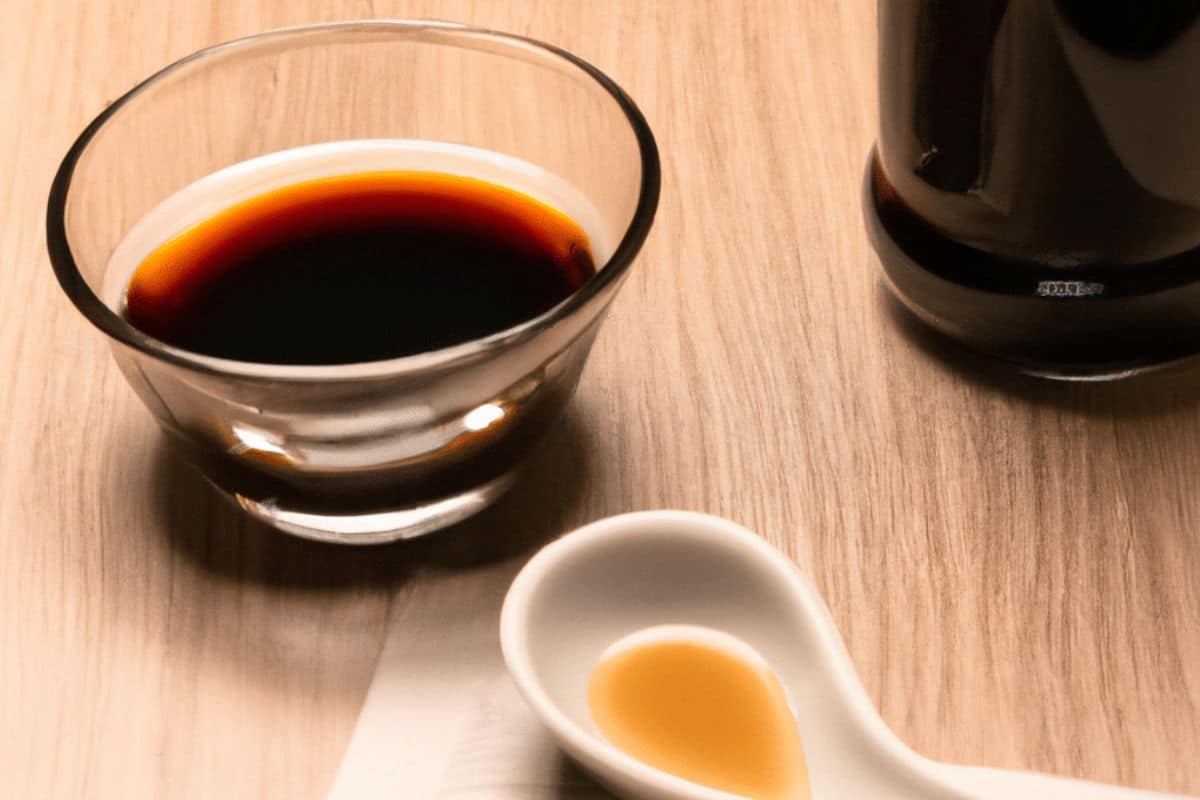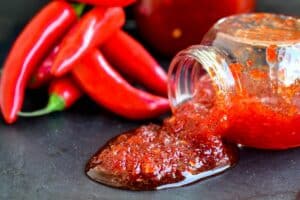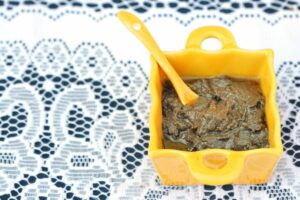Call soy sauce the unsung hero in most kitchens. You’ll find barely a pantry in any home without soy sauce. Its distinct, salty, and tangy taste is what completes most meals.
From stews and salads to soups, Soy sauce is a must-have as it enhances the flavor of any meal.

Originally, soy sauce was from Asia. However, other countries have joined the bandwagon to produce their own soy sauce product commercially.
It’s probably why not all soy sauces taste the same. You might notice that soy sauce from one bottle tastes different from the next.
So what happens if you don’t have soy sauce within reach, have a wheat/soy allergy, or are looking to monitor your sodium intake? Find a worthy substitute! Below are the 14 best light soy sauce substitutes.
1. Dark Soy Sauce
Four common soy sauce varieties are dark, light, sweet, and thick soy sauces. If you’ve run out of light soy sauce, you can prepare your meal using dark soy sauce instead.
If you’re used to taking light soy sauce, you may find the taste of dark soy sauce similar but slightly different.
However, a significant difference will be in the color of your food. While you can expect to enjoy a savory meal, your dish will appear darker when you use dark soy sauce.
If the color of your food doesn’t bother you, consider using diluted dark sauce.
2. Tamari
If you don’t want to veer too far off from the light soy sauce you’re used to, Tamari is your best bet.
Tamari almost looks and tastes like ordinary soy sauce. In fact, the two are so much alike, some people use them interchangeably.
Like soy sauce, Tamari is also brewed from soybeans following similar methods. Tamari doesn’t contain wheat, thus an excellent option for those looking for a gluten-free, vegan-friendly light Soy sauce alternative.
3. Hoisin Sauce
Hoisin sauce’s salty taste makes it the next best light soy sauce substitute to reach for when you can’t find the standard soy sauce.
Hoisin sauce gets made using ingredients like red chili peppers, fennel, garlic, and other seasonings. It’s a dark sauce with a tangy taste that will make your food taste good but also darker.
Feel free to adjust the ratios to prepare meals whose taste meets your preferences. Most people use the same amount of hoisin sauce as soy sauce, and their meals still turn out amazing.
4. Worcestershire Sauce
Worcestershire sauce is a British condiment made from hand-picked ingredients like anchovies, garlic, malt vinegar, onions, sugar, molasses, salt, tamarind extract, and spices.
It’s a fermented sauce that almost tastes like soy sauce, so Worcestershire sauce is an excellent alternative to light soy sauce.
If you’re allergic to soy or wheat, you can use Worcestershire sauce because it neither has soy nor gluten and has less sodium. However, if you’re allergic to seafood, you might want to choose another option.
You can use Worcestershire sauce in any recipe using the same ratios you use with soy sauce.
5. Coconut Aminos
Coconut aminos is a sauce made from fermented coconut sap. It has a similar taste to soy sauce but is significantly sweeter.
If you’re looking to lower your sodium intake and want a gluten-free sauce, coconut aminos will fit right in.
Regular soy sauce has 290 milligrams of sodium per teaspoon, while coconut aminos have a meager 90 milligrams.
This sauce is a great option when you prefer your food to taste less salty without compromising the taste of your soup or other meal.
6. Miso Paste
The best thing about miso paste is how easy it is to find. You can find it in Asian markets or the Asian section of any supply store.
Miso paste is one of the best substitutes for soy sauce because they have nearly the same ingredients.
Miso paste gets made from fermented soybeans, which is the main ingredient in soy sauce hence the similarity in flavor.
Mix equal proportions of miso paste with water to make a sauce before adding it to your recipe.
Consider diluting it more if the paste is still too concentrated. The goal is to create a sauce that meets the consistency and flavor you need to make sumptuous dishes.
7. Anchovies
It’s not the first thing that crosses your mind when looking for the best alternatives for light soy sauce, but if anchovies are the only thing available, you’ll be surprised by how well it works! Anchovies can add flavor to your dish because they have a tasty flavor.
But while the standard sauce has a smooth flowy consistency, anchovies come as solid chunks or a paste that doesn’t break down.
Some prefer to chop anchovies to make them more palatable and to improve their texture.
Anchovies work perfectly in curries, stews, soups, and stir-fries. You might have to use your better judgment to decide how much anchovies to add to your recipe. Either way, rest assured that you’ll have a delicious meal.
8. Liquid Aminos
Liquid aminos is a protein concentrate made from unfermented soybeans. It has the same sodium content as soy sauce but is revered by many because it’s gluten-free and equally tasty. Liquid aminos have a distinct sweet and mild salty flavor.
If you are cautious and don’t want to make your dish too salty, consider using an equal ratio of water and liquid aminos first and only add a bit of salt as necessary.
Liquid aminos are a superb source of essential amino acids, which the body needs to build muscle, increase immunity, and monitor cell signaling and gene expression.
9. Oyster Sauce
Oyster sauce is yet another ideal, gluten-free alternative to light soy sauce. It’s a dark brown or caramel-colored sauce made by mixing cooked oysters, sugar, salt, cornstarch, and water.
Oyster sauce salt levels are less concentrated than your standard soy sauce. However, this doesn’t negate how delicious your food will be if you use good-quality oyster sauce.
If you are looking for a vegan-friendly oyster sauce, ordinary oyster sauce may not cut it. However, some manufacturers prepare vegan-friendly oyster sources using shiitake or oyster mushrooms instead of oyster extracts.
10. Teriyaki Sauce
Ingredients like garlic, honey, ginger, seasoning, and soy sauce make Teriyaki sauce.
Call it an improved version of ordinary soy sauce which is why it’s one of the best light soy sauce substitutes. Teriyaki sauce is an excellent addition to meat dishes, stir-fries, salads, and stews.
It’s a staple used in almost all dishes in Japan. Throughout different countries across the globe, Teriyaki sauce is famous for its mouthwatering flavor and its flawless ability to complement any dish.
Professional chefs recommend using equal soy sauce and water ratios in recipe preparation. But you’re free to use as much or as little Teriyaki sauce as is enough to make your dish delicious.
11. Fish Sauce
Fish sauce will meet your expectations if you want a sufficient replacement for dark or light soy sauce. Fish sauce gets made from ingredients like fish or krill, water, and salt, which are fermented for about two years to make a sauce.
Despite that fish taste that’s hard to miss, fish sauce can be used in any recipe. Note that vegans and people allergic to seafood can’t eat food prepared using fish sauce. There’s a wide range of plant-based options on this list that won’t trigger your allergies.
12. Dried Mushroom Sauce
Dried mushrooms are a delicacy enjoyed in many countries. Their meaty texture makes them excellent as a side dish with pasta, stews, chili, casseroles, and other dishes. Dried mushrooms can be used to make a surprisingly flavorful soy sauce substitute.
Shiitake mushrooms are the best to make dried mushroom sauce. They bring in an unmatched flavor and consistency when you compare them with dried mushroom sauces from various varieties.
This sauce is perfect for you if you want to monitor your sodium levels. Some find that despite using plenty of dried mushroom sauce, adding salt to their recipe helps obtain the desired flavor.
13. Maggi Seasoning
Maggi seasoning is the Swiss version of soy sauce. It’s available as a dark, rich sauce, granulated powder form, or solid cubes.
Maggi seasoning is best used in making soups, scrambled eggs, stews, meat sauces, and some mixed drinks.
It may taste slightly different because it’s made from ingredients like wheat protein, water, sugar, salt, and other preservatives.
Owing to how concentrated Maggi seasoning is, you may need to dilute it with water to achieve the same consistency as light Soy sauce.
14. Salt
Good old salt can replace light soy sauce when making a quick, simple dish. Using a few pinches of salt to season your food will work just as well as soy sauce.
Salt may not add much color or be as flavorful as other light soy sauce substitutes, but a small sacrifice when you don’t want your food to be tasteless.
Final Say
There’s no need to rush to the store when you suddenly run out of soy sauce. You may have a valid substitute in your pantry or kitchen cabinet that can be a great alternative.
Soy sauce is hard to replace. However, above are the top fourteen best light soy sauce substitutes to prepare savory meals that will leave people licking their fingers.







